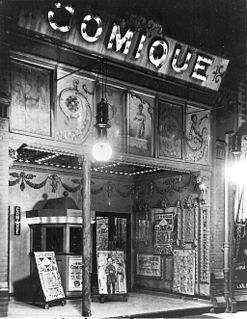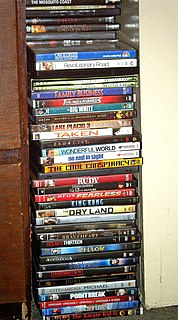Related Research Articles

A cult film or cult movie, also commonly referred to as a cult classic, is a film that has acquired a cult following. Cult films are known for their dedicated, passionate fanbase which forms an elaborate subculture, members of which engage in repeated viewings, dialogue-quoting, and audience participation. Inclusive definitions allow for major studio productions, especially box office bombs, while exclusive definitions focus more on obscure, transgressive films shunned by the mainstream. The difficulty in defining the term and subjectivity of what qualifies as a cult film mirror classificatory disputes about art. The term cult film itself was first used in the 1970s to describe the culture that surrounded underground films and midnight movies, though cult was in common use in film analysis for decades prior to that.

The film industry in Germany can be traced back to the late 19th century. German cinema made major technical and artistic contributions to early film, broadcasting and television technology. Babelsberg became a household synonym for the early 20th century film industry in Europe, similar to Hollywood later.

A silent film is a film with no synchronized recorded sound. Though silent films convey narrative and emotion visually, various plot elements or key lines of dialogue may, when necessary, be conveyed by the use of title cards.

A movie theater, cinema, or cinema hall, also known as a picture house, the pictures, picture theater, the silver screen, the big screen or the movies, is a building that contains auditoria for viewing films for entertainment. Most, but not all, theaters are commercial operations catering to the general public, who attend by purchasing a ticket. Some movie theaters, however, are operated by non-profit organizations or societies that charge members a membership fee to view films.

The nickelodeon was the first type of indoor exhibition space dedicated to showing projected motion pictures in the United States. Usually set up in converted storefronts, these small, simple theaters charged five cents for admission and flourished from about 1905 to 1915.
Direct-to-video or straight-to-video refers to the release of a film, TV series, short or special to the public immediately on home video formats rather than a theatrical release. This distribution strategy was prevalent before streaming platforms came to dominate the TV and movie distribution markets.

Pornographic films (pornos), erotic films, or sex films, are films that present sexually explicit subject matter in order to arouse and satisfy the viewer. Pornographic films present sexual fantasies and usually include erotically stimulating material such as nudity (softcore) and sexual intercourse (hardcore). A distinction is sometimes made between "erotic" and "pornographic" films on the basis that the latter category contains more explicit sexuality, and focuses more on arousal than storytelling; the distinction is highly subjective.

An independent film, independent movie, indie film, or indie movie is a feature film or short film that is produced outside the major film studio system, in addition to being produced and distributed by independent entertainment companies. Independent films are sometimes distinguishable by their content and style and the way in which the filmmakers' personal artistic vision is realized. Usually, but not always, independent films are made with considerably lower budgets than major studio films. In fact, it is not unusual for well-known actors who are cast in independent features to take substantial pay cuts if they truly believe in the message of the film, or if they are returning a favor to a filmmaker, or simply because they want to work with a particular director that they admire. There are many examples of the latter, such as John Travolta and Bruce Willis taking less pay to work with Quentin Tarantino on Pulp Fiction.

The cinema of the United States, also known as Hollywood, has had a large effect on the global film industry since the early 20th century. The dominant style of American cinema is classical Hollywood cinema, which developed from 1913 to 1969 and is still typical of most films made there to this day. While Frenchmen Auguste and Louis Lumière are generally credited with the birth of modern cinema, American cinema soon came to be a dominant force in the emerging industry. As of 2017, it produced the second-largest number of films of any single-language national cinema, after China, with more than 700 English-language films released on average every year. While the national cinemas of the United Kingdom (299), Canada (206), Australia, and New Zealand also produce films in the same language, they are not considered part of the Hollywood system. That said, Hollywood has also been considered a transnational cinema. It produced multiple language versions of some titles, often in Spanish or French. Contemporary Hollywood often outsources production to Canada, Australia, and New Zealand.

The film industry or motion picture industry comprises the technological and commercial institutions of filmmaking, i.e., film production companies, film studios, cinematography, animation, film production, screenwriting, pre-production, post production, film festivals, distribution, and actors. Though the expense involved in making films almost immediately led film production to concentrate under the auspices of standing production companies, advances in affordable filmmaking equipment, as well as an expansion of opportunities to acquire investment capital from outside the film industry itself, have allowed independent film production to evolve.

Jonathan Rosenbaum is an American film critic and author. Rosenbaum was the head film critic for The Chicago Reader from 1987 to 2008, when he retired. He has published and edited numerous books about cinema and has contributed to such notable film publications as Cahiers du cinéma and Film Comment.

Classical Hollywood cinema is a term used in film criticism to describe both a narrative and visual style of filmmaking which became characteristic of American cinema between the 1910s and the 1960s. It eventually became the most powerful and pervasive style of filmmaking worldwide. Similar or associated terms include classical Hollywood narrative, the Golden Age of Hollywood, Old Hollywood, and classical continuity.
Film distribution is the process of making a movie available for viewing by an audience. This is normally the task of a professional film distributor, who would determine the marketing strategy for the film, the media by which a film is to be exhibited or made available for viewing, and who may set the release date and other matters. The film may be exhibited directly to the public either through a movie theater or television, or personal home viewing. For commercial projects, film distribution is usually accompanied by film promotion.
Political cinema, in the narrow sense of the term, is films that portray current or historical events or social conditions through a partisan perspective in order to inform or to agitate the spectator.
Film criticism is the analysis and evaluation of films and the film medium. In general, film criticism can be divided into two categories: journalistic criticism which appears regularly in newspapers, magazines and other popular mass-media outlets; and academic criticism by film scholars who are informed by film theory and are published in academic journals. Academic film criticism rarely takes the form of a review; instead it is more likely to analyse the film and its place within the history of its genre, or the whole of film history.
The UK Cinema Association (UKCA), formerly known as the Cinema Exhibitors Association, is the national trade association for cinema operators in the United Kingdom. The UKCA represents the interests of well over 90 per cent of UK cinema operators by number and market share.

Home video is prerecorded media sold or rented for home viewing. The term originates from the VHS and Betamax era, when the predominant medium was videotapes, but has carried over to optical disc formats such as DVD and Blu-ray. In a different usage, "home video" refers to amateur video recordings, also known as home movies.
A film – also called a movie, motion picture, moving picture, picture or photoplay – is a work of visual art that simulates experiences and otherwise communicates ideas, stories, perceptions, feelings, beauty, or atmosphere through the use of moving images. These images are generally accompanied by sound and, more rarely, other sensory stimulations. The word "cinema", short for cinematography, is often used to refer to filmmaking and the film industry, and to the art form that is the result of it.

Hindi film distribution circuits comprises territories which have been created by film distributors for releasing Hindi cinema or Hindustani cinema across India. The six distribution circuits were created in 1930s after the advent of the first talkie in 1931. These circuits were:
Cinema of Sudan refers to both the history and present of the making or screening of films in cinemas or film festivals, as well as to the persons involved in this form of audiovisual culture of the Sudan and its history from the late nineteenth century onwards. It began with cinematography during the British colonial presence in 1897 and developed along with advances in film technology during the twentieth century.
References
- ↑ Badal, Sharon (2012-07-26). Swimming Upstream: A Lifesaving Guide to Short Film Distribution. Taylor & Francis. ISBN 978-1-136-06125-7.
- ↑ Nasaw, David (2013-08-12). The Chief: The Life of William Randolph Hearst. Houghton Mifflin Harcourt. ISBN 978-0-547-52472-6.